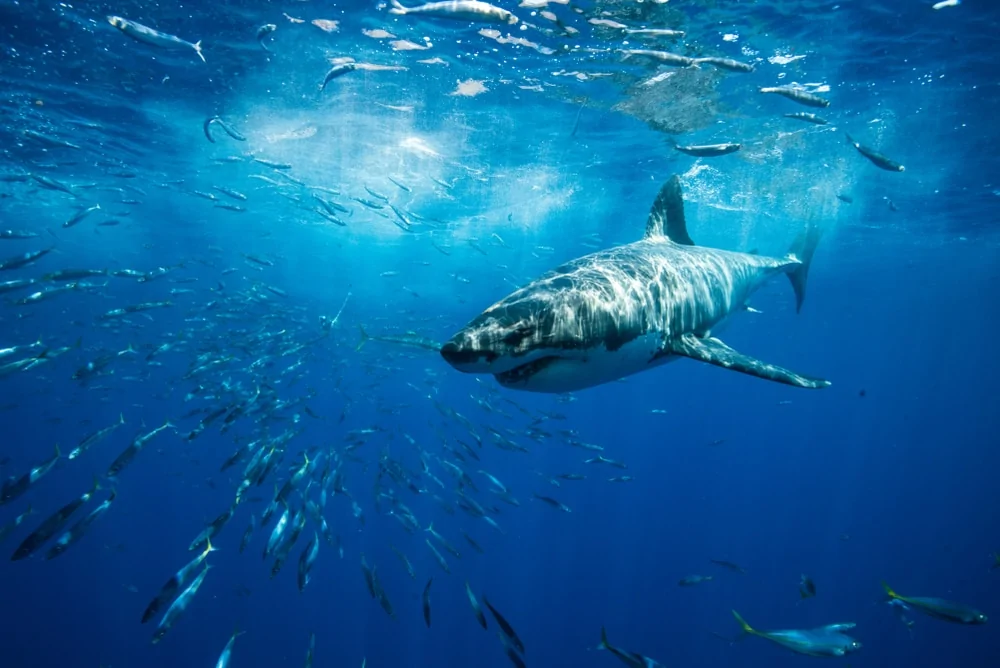
As we got more civilized, our sharks started to touch some part of our brains that we had forgotten about. Some people find the idea of swimming with a shark terrifying, yet it is a reality for millions of unsuspecting individuals every year.
In Florida’s beaches, both tourists and locals alike flock in droves, perhaps giving little consideration to what they share the water with. There is no separating line between you and sharks at the beach, as I can tell you from personal experience. But, there is some good news here.
There are more than forty different shark species in Florida, although the majority of them aren’t considered dangerous to humans. Shark bites, on the other hand, are extremely uncommon. Sharks are fascinating and awe-inspiring creatures in their own right.
It’s worth knowing what sharks are in the water if you’re going to Florida, so keep an eye out.
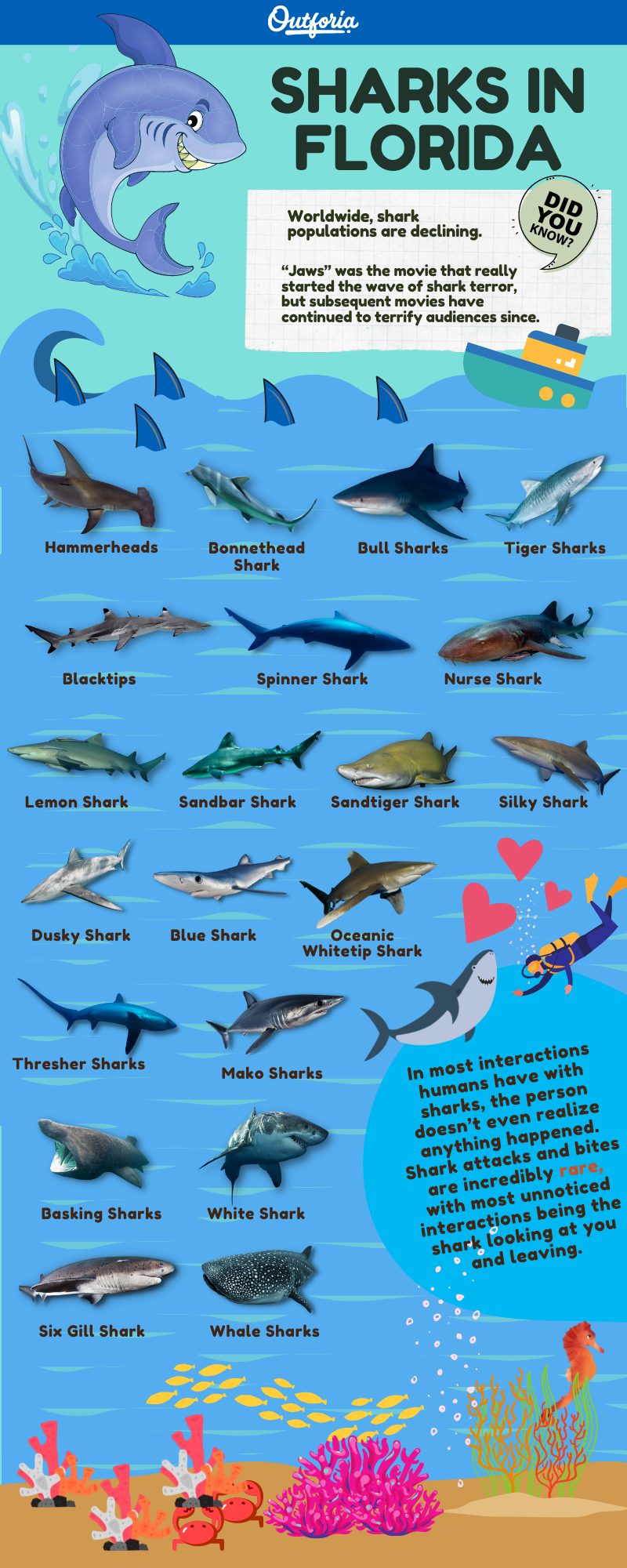
16 Most Common Species of Sharks in Florida
1. Hammerheads (Sphyrnidae)

Great hammerheads, scalloped hammerheads, and smooth hammerheads are the three different species of hammerhead sharks. Due to their flat, hammer-shaped heads, they are some of the most easily recognized sharks.
The largest hammerheads have been discovered to reach 20 feet (6 meters) in length and average around 14 feet (4.3 meters) in breadth, while the rest grow to approximately nine feet (2.7 meters). Hammerheads may be found in coastal waters and around reefs and other structures offshore, so you may find them all throughout Florida.
Hammerheads, like other sharks, feed primarily on whatever is presented to them as a simple meal. Stingrays, skates, and gigantic varieties of crabs that lurk in the sandy bottom of the sea are among their favorite prey.
Great hammerheads are solitary creatures that generally only come together around significant food sources or to mate, while other hammerhead groups may combine in schools in the hundreds.
All hammerhead species are classified as vulnerable or endangered.
2. Bonnethead Shark (Sphyrna tiburo)
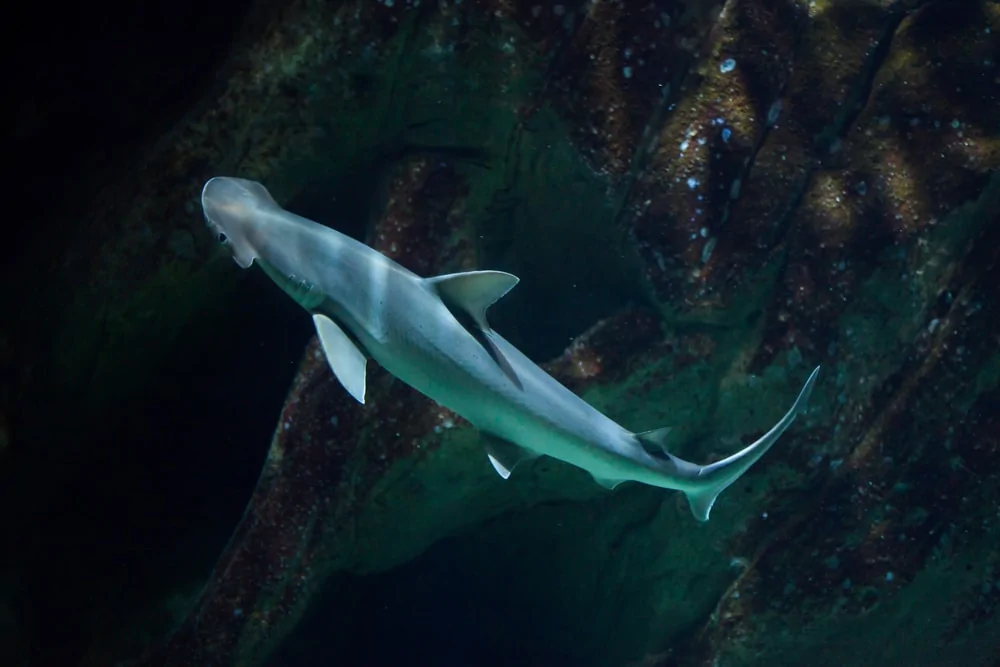
The little cousins of hammerheads, bonnethead sharks have a similar head shape. Bonnetheads are a popular species for very large saltwater aquariums, unlike their larger cousins, who average three to four feet (0.9 to 1.2 meters) in length.
Estersuaries, surf zones, and shallow grass flats are favored habitats for bonnetheads. During the winter, they migrate to warmer waters.
The majority of these sharks’ diets are crabs, shrimp, and other seafloor invertebrates. They swim in zigzag patterns across the seafloor, using their head to sense prey, much like hammerheads do.
Bonnetheads are one of the most frequent sharks in the Gulf of Mexico, with populations numbering in the millions. The species is, however, still endangered across the globe.
The only known sexual dimorphism in the head of a shark is found in bonnetheads. Males have a distinct bulge in their skulls, whereas females have more rounded skulls. This is the basic difference between males and femen.
They eat a lot of seagrasses, which is thought to help protect their stomachs from the sharp edges of shellfish shells. Omnivorous sharks are unusual in this regard.
3. Bull Sharks (Carcharhinus leucas)

Because of their unusual adaptations for living in freshwater and general hardiness, bull sharks are one of the most common sharks found around the world. They have also been found to have gone 1,100 miles (1,770 kilometers) up the Mississippi River from the Gulf of Mexico to Illinois.
Bull sharks can reach lengths of up to 8 feet (2.7 meters) and weigh as much as 800 pounds (363 kilograms). They like to cruise beaches, estuaries, bays, and river mouths in warm coastal waters.
Sharks have a unique capacity to deal with freshwater. Bull sharks are saltwater sharks that can deal with a broad range of salinities, while other species such as the Glyphis are freshwater species. Bull sharks breed in rivers in certain regions.
The great majority of human-injured shark attacks by big bull sharks are called nearshore attacks. Because of their extremely high testosterone levels, aggressive territorial behavior, and zero-tolerance policy towards any kind of provocation, they are often one of the most aggressive species of shark.
The vulnerable species list includes bull sharks.
4. Tiger Sharks (Galeocerdo cuvier)
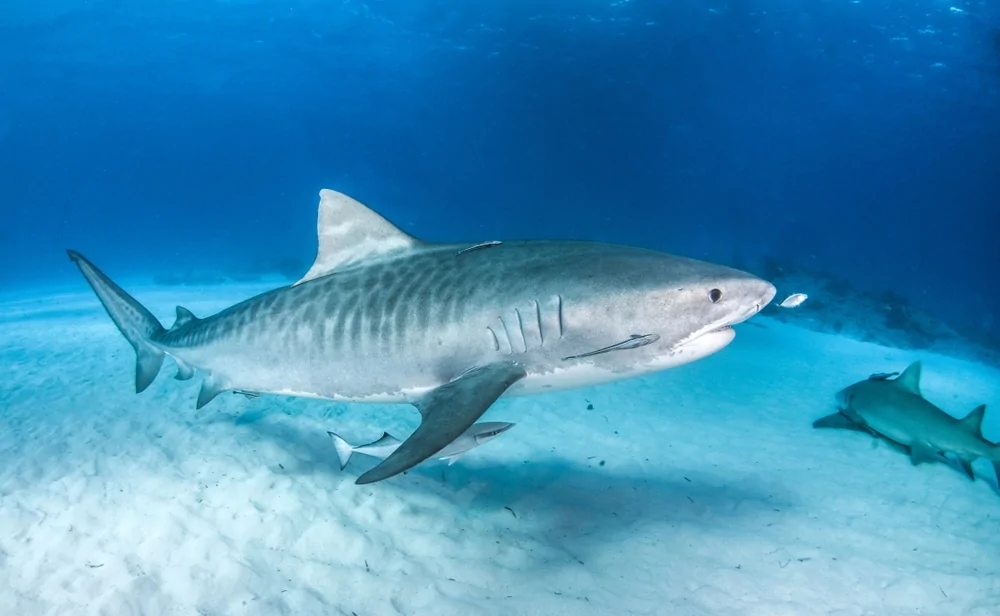
The tiger stripes on a tiger shark’s sides are easily visible. They prefer tropical and subtropical climates, and they can grow to be over 16 ½ feet (5 meters) long. They are prevalent in the Florida Keys and South Florida, but they have been known to travel north in search of dinner.
Sea turtles are the preferred food of many sharks, however they are uncommon. They are renowned for eating practically anything and have the greatest variety of prey of any shark species. The menu includes rays, fish, turtles, other sharks, sea birds, squid, dolphins, and crustaceans. They may devour manufactured items like pieces of metal or whatever else has been floating about, as well as manmade goods.
In terms of the number of fatal attacks on people, tiger sharks are the second most dangerous for humans, behind only the great white. While it’s usually safer to exit the water than share it with a 15-foot (4.5 meters) indiscriminate feeding machine, these assaults occur very infrequently.
The species is listed as near-threatened.
5. Blacktips (Carcharhinus limbatus)
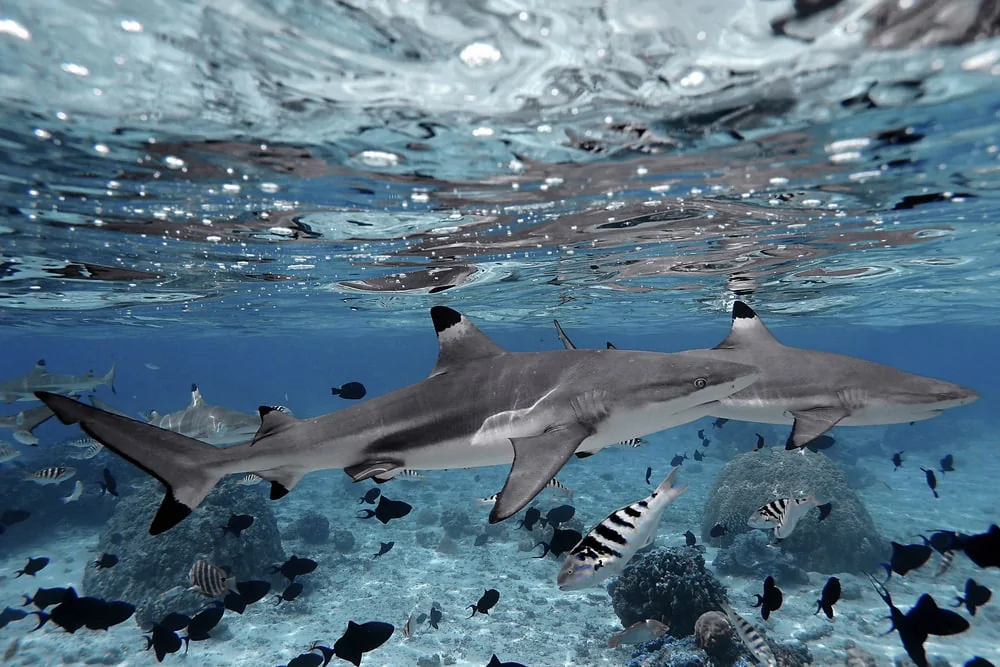
Blacktip sharks prefer brackish, coastal waters and grow to around five feet (1.5 meters) in length. The stout body shape and distinctive black marking on the pectoral and dorsal fins tip of these fish may be used to identify them.
When attacking schools of fish, which comprise the majority of its diet, they’re known for leaping from the water, similar to the spinner shark. They may congregate in large numbers during mating seasons, such as the one shown here, and frequently follow traveling schools of fish down beaches.
They may become dangerous while feeding, resulting in human assaults. They aren’t considered significant dangers, even in the event of an assault, due to their smaller mouth size.
A vulnerable species is blacktips, which are listed. Their importance in commercial and recreational fishing, as well as their meat, fins, and organs, is what accounts for the majority of this.
6. Spinner Shark (Carcharhinus brevipinna)

The blacktip and the spinner shark are physically similar. They both have black markings on their fins and will frequently leap from the water when attacking prey (more so for spinners). The black-marked anal fin and a farther back dorsal fin differentiate spinners from blacktips.
They grow to be around ten feet (3 meters) in length as well. When hunting on schools of fish, spinner sharks favor shallow water and attack from below, spinning while breaching out of the water, which is a favored tactic. Their whole body, like a skateboarder executing a trick, is lifted out of the water in many situations.
The leaping behaviors of the shark when hooked make it a popular fighter and offer excellent table-quality meat.
The species is considered endangered.
7. Nurse Shark (Ginglymostoma cirratum)

Because of their docile nature, nurse sharks are frequently known as “almost puppies.” They’re one of the few species that lie on the seafloor. They’re brownish in color and have two barbels over their lips, enormous rounded fins.
They are the fourth most bite-prone on humans, although they are tolerant of being handled, tagged, or touched (as opposed to other shark species). Their docile nature leads divers to be careless with them, and this is mostly due to the fact that they frequent shark-feeding dive locations.
Nurse sharks are typically around ten feet (3 meters) long when fully grown. Because of the little space they need in comparison to other sharks and their typically amicable disposition, they are a frequent aquarium species.
Nurse sharks are opportunistic feeders that ambush tiny fish and rays when they get too close. Among invertebrate species, they have the ability to develop enormous suction strengths. They’re frequently seen in clusters on the bottom, lying motionless.
The species has been designated as endangered.
8. Lemon Shark (Negaprion brevirostris)

In the warm, shallow waters they call home, lemon sharks spend time in groups and search for fish. They are a sandy-yellow species that grows to around eleven feet (3.3 meters) in length and blends in with the bottom while cruising above it.
Lemon sharks are skittish around humans, thus only a few shark attacks have been attributed to them. They usually associate with sharks of similar size.
Vulnerable status has been assigned to this species.
9. Sandbar Shark (Carcharhinus plumbeus)

The dorsal fin of sandbar sharks is very tall, and the shark has a brown coloration. Sandbar sharks are closely connected to bull sharks. They grow to around eight feet (2.4 meters) in length and are incredibly stocky, making them one of the world’s biggest coastal sharks.
Fish, rays, and crustaceans are the main sources of food for these fish. They prefer shallow nearshore waters over deeper offshore areas and spend a lot of time in intertidal zones, bays, and estuaries.
Sandbar sharks have been targeted more by commercial fisheries looking for shark fins for shark fin soup because of their large dorsal fins. As a result of this, the population has decreased, and landing the species in the United States has been prohibited.
The species has been designated as endangered.
10. Sandtiger Shark (Odontaspis taurus)
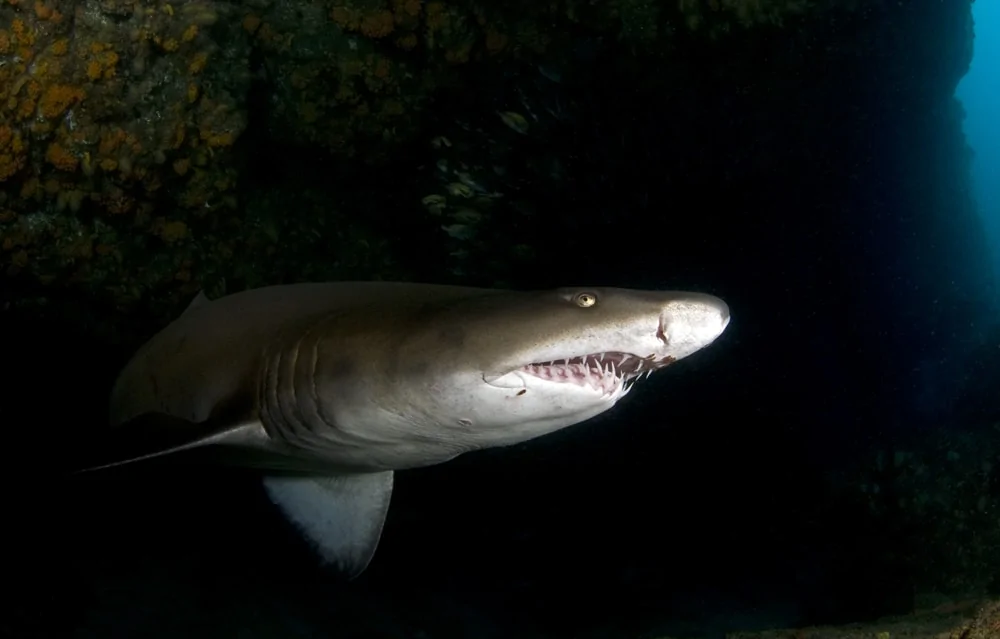
Sandtiger sharks have a horror of fangs but are sluggish and calm in their movements. Their pointed head, grey coloring, and heavy body with an arched back are all characteristics that distinguish them. They grow to be around ten feet (three meters) long.
In a variety of ways, sandtigers are unique. To help them stay buoyant, they may ascend to the surface and swallow air. In the womb, like with some other species of shark, they also practice cannibalism. During pregnancy, the most developed embryo eats the others.
They are one of the most commonly seen sharks in aquariums because to their capacity to adapt to captivity readily.
The species is classified as a critically endangered one.
11. Silky Shark (Carcharhinus falciformis)

Silky sharks are large, greyish-brown fish that live in deep offshore waters and grow to around eight feet (2.4 meters) long. They are most often found near the margins of continental shelves, but when food is scarce, they come closer to shore.
They travel enormous distances, following the trails of fish and squid congregations.
Their peculiar sickle-shaped tail and big eyes help them to be identified further. Silkies may be aggressive toward humans, but they are rarely seen because of their pelagic lifestyle.
It has been classified as vulnerable.
12. Dusky Shark (Carcharhinus obscurus)
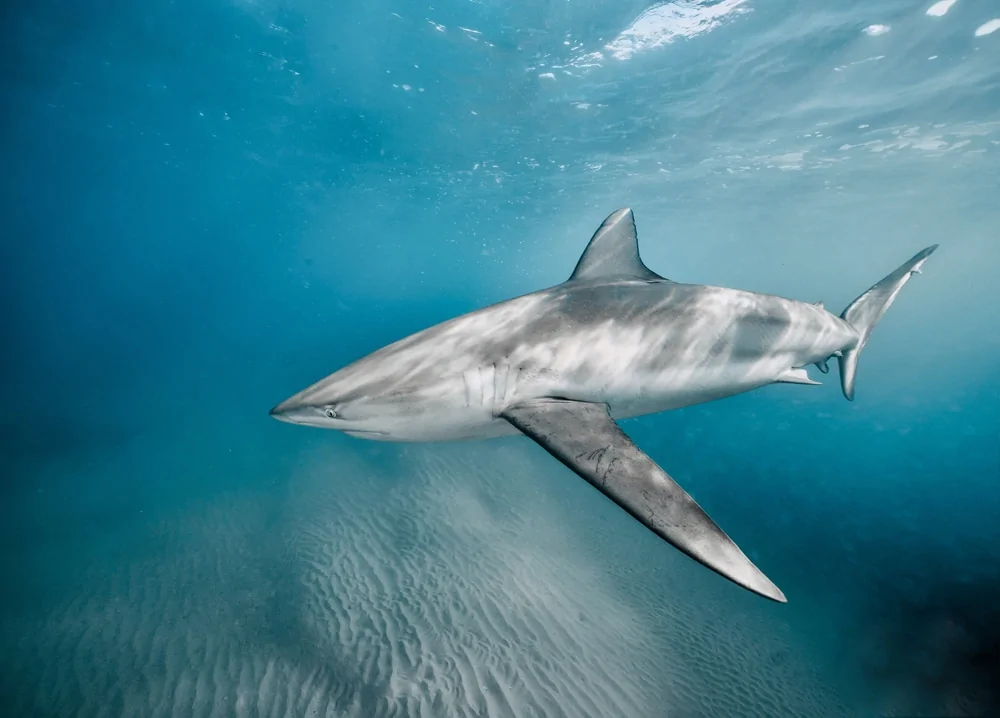
You may identify dark sharks by their usual black-colored backs, slender body, and enormous pectoral fins. They grow up to fourteen feet (4.3 meters) in length. From the shore to the continental shelf’s pelagic zone, they may be found everywhere.
In the summer and winter, dusky sharks travel extensively, heading north at the poles and south at the equator. From fish and rays to crustaceans and even waste, the duskies consume it all.
Despite their high population numbers, they have a slow reproductive rate, making them vulnerable.
13. Blue Shark (Prionace glauca)

The deep blue coloration on the top of their bodies, which helps them blend in with the deep blue water they live in, is what gives blue sharks their name. They have slender bodies and grow to an average of ten feet (3 meters) in length, although they may grow further.
Blue sharks spend the majority of their time in pelagic zones with water depths of more than 400 feet (122 meters), except in Antarctica. Squid makes up the majority of their diet, but cuttlefish, bony fish, and crustaceans are also eaten.
These feeders have been known to devour whale blubber from the dead and are considered opportunistic feeders. Schooling up and hunting in packs, blue sharks are suspected of driving schools of fish into balls that they may subsequently devour at their leisure.
Blue sharks have extraordinarily high reproductive rates, despite being frequently caught in long-line fishing. Because of the large number of shark pups that a single pregnancy may yield, their population continues to grow.
The species is not considered endangered.
14. Mako Sharks (Isurus oxyrinchus)
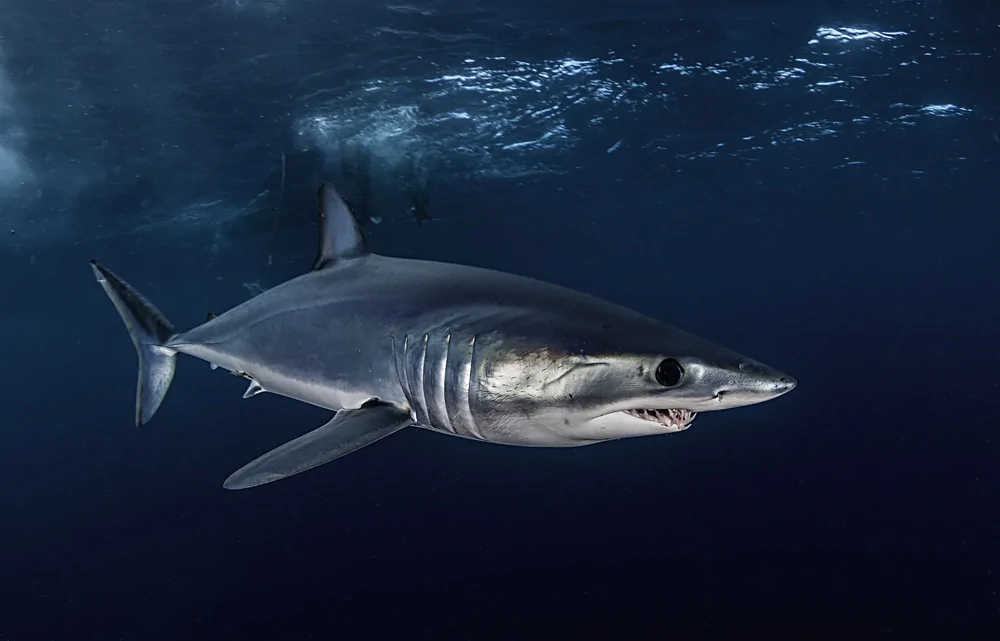
Off the coast of Florida, you may catch both shortfin and longfin mako sharks. Makos have large teeth and enormous eyes, and they resemble torpedoes. Makos average ten feet (3 meters) in length and weigh 300 pounds (136 kilograms), with fourteen-foot (4.2 meters) and 1,200-pound (544 kilograms) specimens being captured. They are also exceptionally heavy for their sizes.
Both species feed on bony fish like tuna and cephalopods like squid, and prefer offshore environments and deeper waters.
Fishermen prize makos for their remarkable ability to fight when hooked up on a line. They frequently leap from the water and attain breakneck speeds. Shortfin makos can swim at speeds of over 30 miles (48 kilometers) per hour, and they may reach speeds of up to 46 miles (74 kilometers) per hour. They are one of the fastest swimming creatures on Earth.
Most Makos attacks are the consequence of a provoked fish being brought on board a boat that had hooked it while fishing. However, they are known to be dangerous to humans.
The mako shark populations in both types are designated as endangered.
15. Oceanic Whitetip Shark (Carcharhinus longimanus)

Pelagic species include Oceanic White Tips, which spend their entire lives at sea. They may grow to be up to 13 feet (4 meters) in length, averaging roughly 10 feet (3 meters). Their confrontational demeanor, distinct white marking on the dorsal fin, and stocky physique with unusually large fins may be used to differentiate them.
White tips are slow-swimming opportunistic predators. They conserve energy and eat whenever they can because they spend all of their time in the typically barren open ocean.
They’re noted for gathering in vast numbers on bait balls and can smell or sense out food sources from miles away.
They may detect or sense food sources from enormous distances and are noted for gathering in huge groups around bait balls.
for a reason, white tips are referred to as sea dogs. Due to their curiosity, they often follow ships or appear where people are diving. One of the reasons they pose a danger to ship and aircraft wreck survivors is because of their capacity to travel great distances toward sensed-out food sources.
The species is designated as endangered.
16. Thresher Sharks (Alopias)
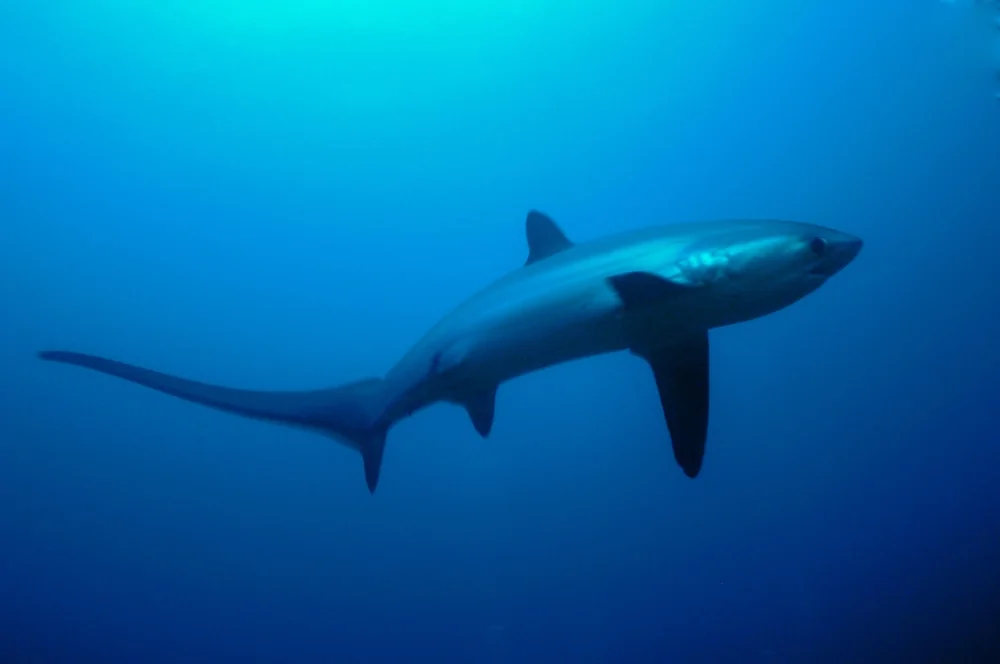
The whip-like tail of thresher sharks distinguishes them from other species and sets them apart. They feed on Bonita, tuna, and other bony, open-water fish for the majority of their time in the open ocean.
The tail is a weapon that they are recognized for using. They can swiftly slice fish in two or paralyze the victim they’re pursuing when they move through a school of fish. This phenomenon is unique among sharks.
The species has been classified as endangered.
4 Other Florida Shark Species You’ll Find
Florida’s seas are home to over forty different shark species, as previously stated. A few well-known species may be discovered here, in addition to the ones mentioned above.
1. Whale Sharks (Rhincodon typus)
In the Gulf of Mexico, you may find whale sharks, the world’s biggest creature outside whales. They are filter feeders that may grow to be fifty feet (15 meters) long and eat plankton and other tiny creatures.
2. Basking Sharks (Cetorhinus maximus)

Basking sharks, a filter feeder similar to great whites, may also be found off the coast of Florida. Except for their feeding habits and enormous size of over 30 feet (9 meters), little is known about the species.
3. White Shark (Carcharodon carcharias)

Great whites are known to travel through Florida and into the Gulf of Mexico, according to a diver. In order to find food and breeding grounds, Atlantic great whites frequently travel between Maine and the Gulf of Mexico. The most deadly for humans are great whites, which grow over 20 feet (6 meters) in length. Yet, in a later section, we’ll discuss that.
4. Six Gill Shark (Hexanchus griseus)

You might expect to find dogfish sharks, cookie-cutter sharks, six and sevengill sharks, and even shark relatives like chimeras if you include the deep ocean off the continental shelf. These species, which live in the deep ocean where light does not reach, are unlikely to be encountered.
Sharks of Florida And Human Interactions
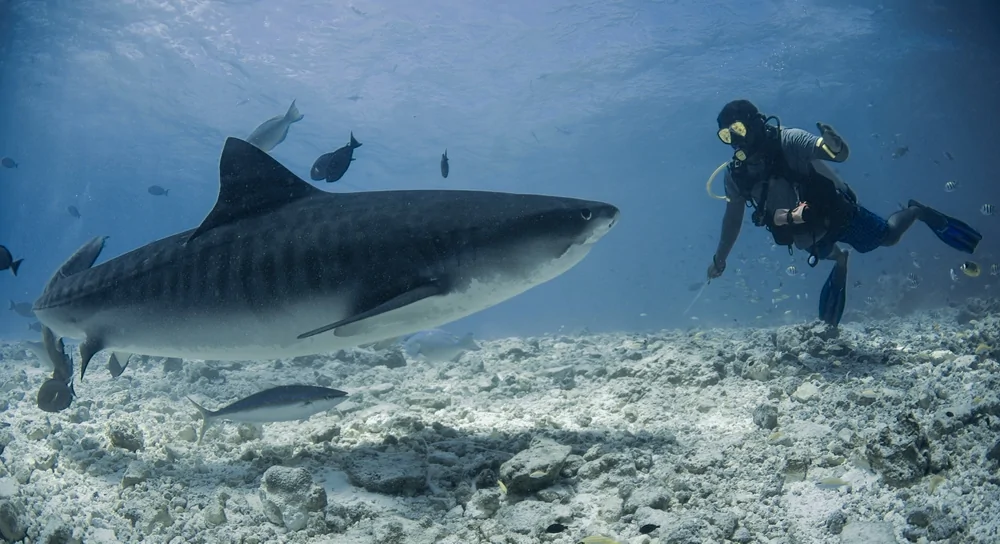
Humans don’t realize anything happened in the majority of their interactions with sharks. The majority of shark sightings and bites are uneventful, although the shark may look at you before departing.
Fewer than 80 shark bites occur each year in the wild. Provoked and unprovoked bites are separated into two categories. Unhooking them from a line, attempting to handle them, or otherwise sparking the animal are all examples of provoked bites. When a shark bites without any known cause, it is referred to as an unprovoked bite.
39 provoked and 57 unprovoked bites were reported in 2020. Just 13 people died as a result of it.
Shark attacks are the most common in the United States, with Florida accounting for the majority of incidents. Here you may see information on the 2020 shark bite.
Most unprovoked wounds are caused by territorial conduct or exploratory wounds, so it’s important to recall that. When a shark is testing to see if you are food or not, exploratory bites may occur as a result of mistaken identity. The shark bites once and then departs in the great majority of cases.
A swimmer in the water appears to be a seal or turtle (particularly while surfing) from the perspective of a shark. The shark usually bites you before realizing you aren’t edible and letting go. However, an exploratory bite from huge sharks like great whites and tiger sharks may cause catastrophic injury.
It’s vital to remember that shark attacks are extremely uncommon, and even if they occur, they are seldom fatal.
Sharks are often encountered if you swim in the sea. Sharks don’t purposefully attack humans, so we aren’t what they’re looking for.
You’re the one who’s trespassing, and the water isn’t shark-infested. They live there. See this Florida Fish and Wildlife blog entry for more tips on how to share water with sharks.
Threats to Florida Shark Population
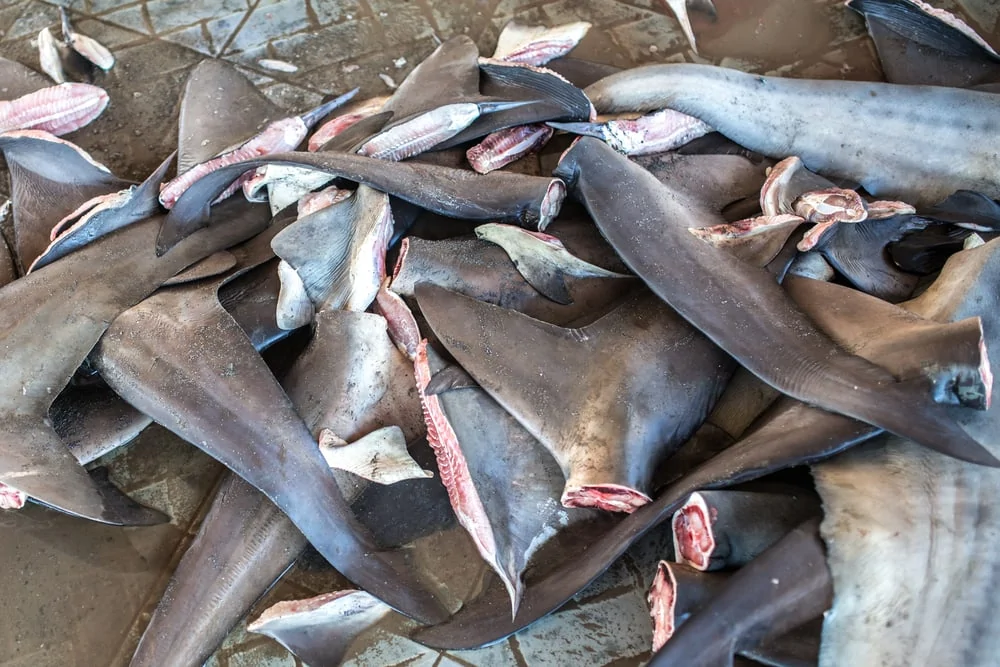
Shark populations are declining around the world. However, overfishing is one of the main reasons that contributes to this.
Almost 100 million sharks are caught each year for their fins. In Asia, shark fin soup is a costly luxury. Several governments have banned shark finning because of environmental and ethical concerns.
Shark fishing boats capture the sharks and slice off their fins while they are still alive in numerous circumstances. The rest of the shark is expendable, so it is thrown back into the sea with no fins. Since it can no longer swim, the shark dies.
Because of shark finning, some sharks are hit harder than others.
Sharks are captured as bycatch by trailers and long-line fishing boats in addition to commercial shark finning. Sharks die in the nets or on the lines in tens of millions of cases each year, according to estimates.

Shark populations are also threatened by ocean pollution and climate change. Mercury and other toxins in the water move up the food chain, making sharks sick and unable to reproduce. Ocean acidification speeds up as the climate changes, harming the food chain from the bottom up.
Shark prey species are overfished, limiting their food supply. Shark populations become unsustainable as fish stocks diminish due to a number of factors. As an illustration, due to the reappearance of seal populations in New England, great white shark populations have increased as well. Unfortunately, the positive trend for all sharks is not continuing.
Sharks are our greatest enemy. Via our indirect and direct activities, such as planting trees and shark culls, we are contributing to global warming.
Shark populations have declined, and this has ripple effects throughout the food chain. Without adequate apex predators, whole ecosystems will collapse if prey populations are not controlled.
Historical Change in Sharks Living in Florida Waters
Shark populations in Florida have decreased for many of the same reasons described above as threats. Sharks are having reproductive difficulties, habitat problems, and shorter life spans, not to mention that they are becoming increasingly difficult to find.
Shark Fishing

Sharks are caught for both commercial and recreational purposes.
Sharks are captured for their meat, fins, teeth, and organs in order to sell them. The desire for shark fin soup is what drives shark finning, as described above. Several of their organs, such as Traditional Chinese Medicine, are utilized in medicinal procedures. Their skin may be utilized to make leather.
Because of their stunning and powerful battling skills, many sharks are desired as trophy fish by recreational fisherman. Recreational fisherman, both from the shore and in boats, seek out sharks in a number of ways.
Several fisherman fish for offshore species such as mako sharks and threshers from boats. Spinners, blacktips, and bull sharks are the most common targets from shore. While substantial gear is normally employed to capture big sharks fast, smaller species are frequently caught by accident with baits like shrimp and squid.
Several sharks don’t survive when they are shark-fished for leisure. When they are frightened (such as battling on a line), sharks release cortisol. The rise in stress hormones affects various species differently. Some species, such as bull sharks, have a 97% survival rate, whereas others, such as hammerheads, have a death rate of 40-70%.
Whether the animal is injured during capture and release or recovers and swims away seeming to be fine, it makes no difference.
As a result of this, I decided to stop pursuing sharks for catch and release because of the information. The chance of the animal surviving is minimal regardless of how quickly you transport it in, unhook it, and return it to the water.
I would caution others not to target sharks for fun as a Florida fisherman and former shark fisherman. To be considered a responsible angler, there must be too much outside of your control.
Cultural References

Sharks dominate the cultures of coastal and island peoples throughout history.
Sharks have even made their way into popular culture, with a shark bite serving as a major news story (mostly due to their rarity).
The Shallows, Deep Blue Sea, The Meg, and Sharknado are all centered around sharks, with “Jaws” being the film that truly started the wave of shark terror.
Similar to how we react to tigers, lions, and bears, humans have a basic reaction to sharks. Sharks elicit an innate fear in us as a species that may prey on us. Nowadays, the animals pose little danger to us. We must increase our management of shark populations, which is their main danger.
